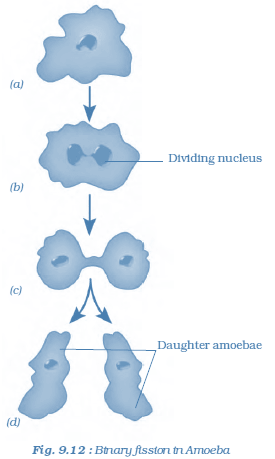
This process involves replication of the cells. Binary fission (division into two) Definition: A common type of asexual reproduction in prokaryotes like bacteria, where a parent cell divides to form two identical cells and each having the potential to grow to the size of of the original cell. This process requires the division of mitochondrial proteins and DNA. Prokaryotic cells, which include bacteria, undergo a type of cell division known as binary fission. Mitochondria, for example, divide by prokaryotic binary fission. In addition to organisms in the Archaea and Bacteria domains, some organelles in eukaryotic cells also reproduce via binary fission. Fission of Organelles in Eukaryotic Cells

Thus, binary fission occurs at much lower rates in bacterial cultures that have encountered a growth-limiting factor (i.e., entered a stationary growth phase). Bacterial growth, however, is limited by factors including nutrient and space availability. For example, Escherichia coli cells typically divide every 20 minutes. In the amount of time it takes bacterial cells to undergo binary fission, the number of cells in the bacterial culture doubles. Though its speed varies among species, binary fission is generally rapid and can yield staggering growth. This asexual method of reproduction produces cells that are all genetically identical. Organisms in the Archaea and Bacteria domains reproduce using binary fission, in which a parent cell splits into two parts that can each grow to the size of the original parent cell. When the septum is finished developing, it pinches off the cell, splitting to yield two identical daughter cells.įission is the division of a single entity into two or more parts, which regenerate into separate entities that resemble the original. Now a ring of self-assembling proteins forms at the cell midpoint, directing the formation of a septum ring, a developing cell wall from the midpoint peripheries to the middle. Once the chromosomes have moved to opposite sides, cytoplasmic separation, cytokinesis can begin. The cell itself lengthens, spurring chromosomal or nucleoid separation.

Replication enzymes copy the chromosome bidirectionally, moving in opposite directions from the origin to create two double-stranded chromosomes.Īs replication occurs, both chromosomes begin to move away from each other, to opposite sides of the cell. To divide, the cell first replaces its DNA, copying the chromosome from its origin of replication, an area near chromosomal contact with the cell plasma membrane. This type of reproduction is termed binary fission, meaning division in half.

Prokaryotes propagate via cell division, albeit by using a different process than eukaryotes, one that's asexual, forming two genetically identical clones of itself.


 0 kommentar(er)
0 kommentar(er)
